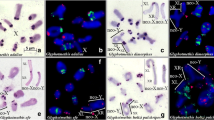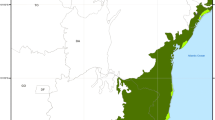Abstract
The Pseudopimelodidae family comprises 35 species however, cytogenetic studies have been performed in only six species. This study uncovered karyotypic data on Pseudopimelodus pulcher and Microglanis cottoides. Both species possessed 2n = 54, with 20m + 16sm + 10st + 8a and FN = 100 for P. pulcher and 30m + 14sm + 6st + 4a and FN = 104 for M. cottoides. A female of M. cottoides with 45m + 21sm + 9st + 6a (2n = 81) plus two extra small chromosomes was found, indicating a natural triploidy with supernumerary chromosomes. The formation of the polyploid individual seems to have come from a diploid female gamete, due to the presence of a marker chromosome pair partially heterochromatic presents only in females and common to that exemplar. This triploid female showed three chromosomes with nitrate staining (AgNOR), 18S rDNA probe and chromomycin A3 (CMA3) staining. AgNORs were observed on pairs 12 and 23 in P. pulcher and pair 24 in M. cottoides, results that were confirmed with an 18S rDNA probe and CMA3 fluorochrome. These are the first chromosomal data for P. pulcher and provide the first description of natural triploidy with the presence of supernumerary chromosomes in this family and emphasizing well the chromosomal rearrangements diversification between this species.



Similar content being viewed by others
References
Alcaraz HSV, Da Graça WJ, Shibatta OA (2008) Microglanis carlae, a new species of bumblebee catfish (Siluriformes: pseudopimelodidae) from the rio Paraguay basin in Paraguay. Neotrop Ichthyol 6:425–432
Bertollo LAC, Takahashi CS, Moreira-Filho O (1978) Cytotaxonomic considerations on Hoplias lacerdae (Pisces, Erythrinidae). Bras J Genet 1:103–120
Bockmann FA, Guazzelli GM (2003) Family Heptapteridae. In: ReisRE, KullandeR SO, Ferraris jr CJ. Check list of the Freshwater Fishes of South and Central America.Edipurcs, Porto Alegre, pp 406–431
Cuellar O, Uyeno T (1972) Triploidy in rainbow trout. Cytogenetics 11:508–515
Ferraris Jr CJ (2007) Checklist of catfishes, recent and fossil (Osteichthyes: Siluriformes), and catalogue of Siluriformes primary types. In: Zootaxa, pp 352–356
Galetti PM Jr (1998) Chromosome diversity in neotropical fishes: NOR studies. Ital J Zool 65:53–56
Garcia C, Moreira-Filho O, Bertollo LAC, Centofante L (2003) B chromosomes and natural triploidy in Rhamdia sp. (Pisces, Siluriformes, Heptapteridae). Cytologia 68:403–411
Hatanaka T, Galetti PM Jr (2004) Mapping of the 18S and 5S ribosomal RNA genes in the fish Prochilodus argenteus, Agassiz 1829 (Characiformes, Prochilodontidae). Genetica 122:239–244
Howell WM, Black DA (1980) Controled silver staining of nucleous organizer regions with a protective colloidal developer: a 1-step method. Experientia 36:1014–1015
Kantek DLZ, Noleto RB, Fenocchio AS, Cestari MM (2007) Cytotaxonomy, heterochromatic polymorphism and natural triploidy of a species of Astyanax (Pisces, Characidae) endemic to the Iguaçu river basin. Braz Arch Biol Technol 50:67–74
Levan A, Fredga K, Sandberg AA (1964) Nomenclature for centromeric position on chromosomes. Hereditas 52:201–220
Maistro EL, Dias AL, Foresti F, Oliveira C, Moreira-Filho O (1994) Natural triploidy in Astyanax scabripinis (Pisces, Characidae) and simultaneous occurrence of macro B-chromosomes. Caryologia 47:233–239
Malacrida ACCP, Dias AL, Giuliano-Caetano L (2003) Natural triploidy in Astyanax aff. scabripinnis (Pisces, Characidae) of the Tibagi river bay-PR. Cytologia 68:267–270
Marques MBA, Moreira-Filho O, Garcia C, Margarido VP (2008) Cytogenetic analyses of two endemic fish species from the São Francisco river basin: Conorhynchus conirostris and Lophiosilurus alexandri (Siluriformes). Genet Mol Biol 31:215–221
Martinez ERM, Oliveira C, Foresti F (2004) Cytogenetic analyses of Pseudopimelodus mangurus (Teleostei: Siluriformes: Pseudopimelodidae). Cytologia 69:419–424
Martinez ERM, Nirchio M, Granado A, Foresti F, Oliveira C (2008) Cytogenetic analysis of three catfish species of the family Pseudopimelodidae (Teleostei, Siluriformes). Genet Mol Biol 31:692–696
Ottoni FP, Mattos JLO, Barbosa MA (2010) Description of a new species of Microglanis from the rio Barra Seca basin, southeastern Brazil (Teleostei: Siluriformes: Pseudopimelodidae). Vertebrate Zoology 60:187–192
Pansonato-Alves JC, Oliveira C, Foresti F (2011) Karyotypic conservatism in samples of Characidium cf. zebra (Teleostei, Characiformes, Crenuchidae): physical mapping of ribossomal genes and natural triploidy. Genet Mol Biol 34:208–213
Pinkel D, Straume T, Gray JW (1986) Cytogenetic analysis using quantitative, high-sensitivity, fluorescence hybridization. Proc Natl Acad Sci USA 83:2934–2938
Reis RE, Kullander SO, Ferraris jr CJ (2003) Check list of the freshwater fishes of South and Central America. Edipurcs, Porto Alegre, p 742
Ruiz WBG, Shibatta OA (2010) A new species of Microglanis (Siluriformes, Pseudopimelodidae) from lower Rio Tocantins basin, Pará, Brazil, with description of superficial neuromasts and pores of lateral line system. Zootaxa 2632:53–66
Ruiz WBG, Shibatta OA (2011) Two new species of Microglanis (Siluriformes: Pseudopimelodidae) from the upper-middle rio Araguaia basin, Central Brazil. Neotrop Ichthyol 9:697–707
Schweizer D (1980) Simultaneous fluorescent staining of R bands and specific heterochromatic regions (DA-DAPI bands) in human chromosomes. Cytogenet Cell Genet 27:190–193
Shibatta OA (2003) Family Pseudopimelodidae. In: Reis RE, Kullander SO, Ferraris Jr CJ (eds) Check list of the freshwater fishes of south and Central America. Edipurcs, Porto Alegre, pp 406–431
Silva M, Matoso DA, Ludwig LAM, Gomes E, Almeida MC, Vicari MR, Artoni RF (2011) Natural triploidy in Rhamdia quelen identified by cytogenetic monitoring in Iguaçu basin, southern Brazil. Environ Biol Fish 91:361–366
Sumner ATA (1972) Simple technique for demonstrating centromeric heterochromatin. Exp Cell Res 75:304–306
Swarça AC, Fenocchio AS, Dias AL (2007) An update cytogenetic review for species of the families pseudopimelodidae, pimelodidae and heptapteridae (pisces, siluriformes) suggestion of a cytotaxonomical classification. Caryologia 60:338–348
Tiwary BK, Kirubagaran R, Ray AK (2004) The biology of triploid fish. Rev Fish Biol Fish 14:391–402
Tsuda JR, Moraes VPO, Giuliano-Caetano L, Dias AL (2010) Occurrence of natural triploidy in Rhamdia quelen (Siluriformes, Heptapteridae). Genet Mol Res 9:1929–1935
Venere PC, JrPM Galetti (1985) Natural triploidy and chromosome B in the fish Curimata modesta (Curimatidae, Characiformes). Rev Brasil Genet 7:681–687
Vissotto PC, Foresti F, Oliveira C (1999) Karyotype description of five species of Pimelodidae (Teleostei, Siluriformes). Chromosom Sci 3:1–7
Acknowledgments
The authors are grateful to Dra. Lucia Giuliano Caetano and Dr. Alberto Sergio Fenocchio for the review of this manuscript and to MSc Bruno Ambrozio Galindo for the collection of Pseudopimelodus pulcher specimens. This research was supported by a grant from Coordenação de Aperfeiçoamento de Pessoal de Nível Superior (CAPES). The researcher received permission from Instituto Brasileiro do Meio Ambiente e dos Recursos Naturais Renováveis (IBAMA) to collect fish specimens.
Author information
Authors and Affiliations
Corresponding author
Rights and permissions
About this article
Cite this article
Gouveia, J.G., de Moraes, V.P.O., Pires, L.B. et al. Comparative cytogenetics between two species of the family Pseudopimelodidae (Siluriformes): occurrence of natural triploidy and supernumerary chromosomes. Cytotechnology 67, 215–222 (2015). https://doi.org/10.1007/s10616-013-9676-x
Received:
Accepted:
Published:
Issue Date:
DOI: https://doi.org/10.1007/s10616-013-9676-x




